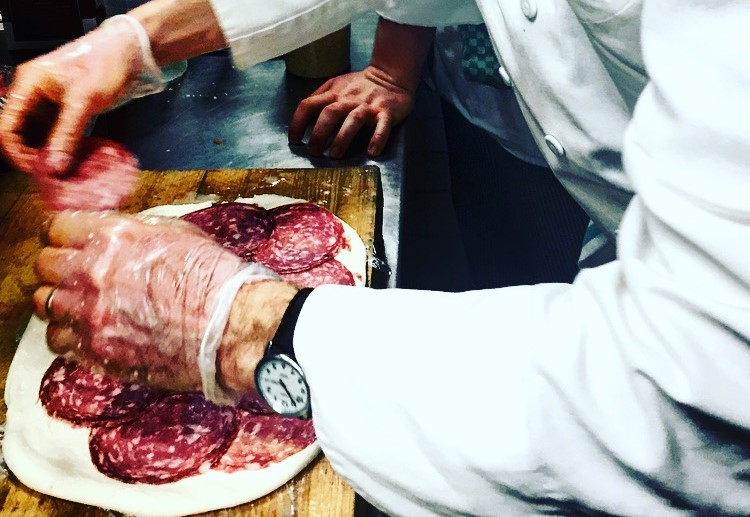Knead Stretch Pinch: "Mozzarella!"
 Perline, Chilegine,Bocconcini, Ovoline, and Rotundine as beautifully written, are the names of Italy's mozzarella shapes. Perline is the smallest, working its way up to the larger, Rotundine. And interestingly enough, Bocca means mouth, with bocconcini symbolizing, the perfect ball of mozzarella to fit inside ones mouth. Whether we eat fresh mozzarella in a Caprese salad, or melt it into Pasta alla Norma, there are the many different sizes to choose from. To make mozzarella, the chef must gather milk (preferably whole), citric acid, and rennet (helps make the cheese sturdy); the ingredients are heated between 90- 105 degrees throughout the whole process. Once the milk mixture curdles forming a custard like consistency, it is nearly done. At this point you may start kneading the curd to form mozzarella and shape into its various sizes. Some may use the whole ball and stretch it out for a roulade (see above); this method, known as pasta filata, means to stretch the curd. And the term Mozara, comes from a fisherman's term meaning to pinch the head off a fish. When making mozzarella, one must pinch the curd into the desired sizes and toss into an ice water bath. Buratta is a softer form of mozzarella, made in the same way as the delectable curd, with the addition of a few things. After forming the shape of the mozzarella, the chef takes a mixture of heavy cream and leftover mozzarella shards, and pours it inside the middle of the mozzarella.The ball is tied with a leek leave, securing its shape, and later removed once it has cooled. It can be served at room temp with EVOO, balsamic reduction/pesto, and crostini. The preparation of buratta came about, as a way to use the leftover pieces of mozzarella in the whey.
Perline, Chilegine,Bocconcini, Ovoline, and Rotundine as beautifully written, are the names of Italy's mozzarella shapes. Perline is the smallest, working its way up to the larger, Rotundine. And interestingly enough, Bocca means mouth, with bocconcini symbolizing, the perfect ball of mozzarella to fit inside ones mouth. Whether we eat fresh mozzarella in a Caprese salad, or melt it into Pasta alla Norma, there are the many different sizes to choose from. To make mozzarella, the chef must gather milk (preferably whole), citric acid, and rennet (helps make the cheese sturdy); the ingredients are heated between 90- 105 degrees throughout the whole process. Once the milk mixture curdles forming a custard like consistency, it is nearly done. At this point you may start kneading the curd to form mozzarella and shape into its various sizes. Some may use the whole ball and stretch it out for a roulade (see above); this method, known as pasta filata, means to stretch the curd. And the term Mozara, comes from a fisherman's term meaning to pinch the head off a fish. When making mozzarella, one must pinch the curd into the desired sizes and toss into an ice water bath. Buratta is a softer form of mozzarella, made in the same way as the delectable curd, with the addition of a few things. After forming the shape of the mozzarella, the chef takes a mixture of heavy cream and leftover mozzarella shards, and pours it inside the middle of the mozzarella.The ball is tied with a leek leave, securing its shape, and later removed once it has cooled. It can be served at room temp with EVOO, balsamic reduction/pesto, and crostini. The preparation of buratta came about, as a way to use the leftover pieces of mozzarella in the whey.